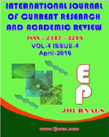Abstract Volume:4 Issue-4 Year-2016 Original Research Articles
 |
Online ISSN : 2347 - 3215 Issues : 12 per year Publisher : Excellent Publishers Email : editorijcret@gmail.com |
2Plant Protection Research Department, Lorestan Agricultural and Natural Resources Research Center, Agricultural Research Education and Extension Organization (AREEO)
3Islamic Azad University, College of Agriculture, Pishva Branch, Varamin, Tehran, Iran
Natural infection by mainly Luteovirises was investigated in chickpea (Cicer arietinum L.) in chickpea growing areas of North Western (NW) provinces of Iran. During 2015 growing season, a total of 170 selected chickpea plants with general yellowing symptoms, including foliar bronzing and stunting, reddening of leaf margins, narrow leaves, and general growth reduction were screened for infection using tissue blot immunoassay (TIBA) and DAC- ELISA. On the basis of 170 plant samples tested, 129 were shown to be infected to at least 5 viruses. On descending order, number of infected sample positive to BLRV using specific poly and two different monoclonal antibodies were 44 (26%) samples, 75 (44%) by using Mab- B-2-5G4 and 89 (52%) with Mab 4-6G6 antibodies. SbDV was positive in 56 samples (33%), CpCSV in 29 (17%), BWYV in 32 (19%), and 12 samples (7%) were shown to be infected by FBNYV (nanovirus) respectively. Luteoviruses including BLRV, CpCSV, SbDV, and BWYV were the most prevalent viruses infecting chickpea plant in NW provinces of Iran.
How to cite this article:
Shahraeen Nooh, Ghotbi Tabassom, Haji Yousef Tara, Azadbakht Nader and Bananej Kaveh. 2016. An Overview of Viral Disease on Chickpea and Impact on Chickpea Production in Iran.Int.J.Curr.Res.Aca.Rev. 4(4): 98-109doi: http://dx.doi.org/10.20546/ijcrar.2016.404.012



Quick Navigation
- Print Article
- Full Text PDF
- How to Cite this Article
- on Google
- on Google Scholor
- Citation Alert By Google Scholar
